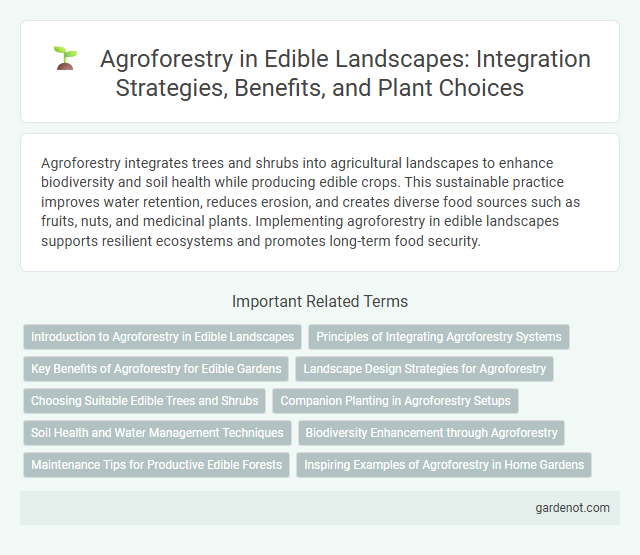Agroforestry integrates trees and shrubs into agricultural landscapes to enhance biodiversity and soil health while producing edible crops. This sustainable practice improves water retention, reduces erosion, and creates diverse food sources such as fruits, nuts, and medicinal plants. Implementing agroforestry in edible landscapes supports resilient ecosystems and promotes long-term food security.
Introduction to Agroforestry in Edible Landscapes
Agroforestry integrates trees and shrubs into agricultural landscapes to enhance biodiversity and sustainability while providing edible products such as fruits, nuts, and herbs. This land management system improves soil health, conserves water, and supports wildlife habitats, making it an eco-friendly approach to food production. Edible landscapes using agroforestry techniques optimize nutrient cycling and create resilient food systems adaptable to climate change.
Principles of Integrating Agroforestry Systems
Agroforestry integrates trees, crops, and livestock to enhance biodiversity and improve soil health, water retention, and carbon sequestration. Key principles include selecting complementary species that optimize resource use, promoting multi-layered vegetation structures, and maintaining ecological balance to sustain productivity. This approach enhances ecosystem services while supporting food security and resilient edible landscapes.
Key Benefits of Agroforestry for Edible Gardens
Agroforestry enhances edible gardens by improving soil fertility through nitrogen fixation and organic matter accumulation, leading to healthier plant growth and increased yields. This sustainable system promotes biodiversity, creating habitats for pollinators and natural pest predators that reduce the need for chemical inputs. Agroforestry also supports water retention and erosion control, ensuring more resilient garden ecosystems and consistent food production.
Landscape Design Strategies for Agroforestry
Agroforestry landscape design integrates multifunctional tree species with crops to optimize biodiversity, soil health, and water retention, creating sustainable edible landscapes. Strategic spatial arrangement involves stacking vertical layers of plants--trees, shrubs, and ground crops--to maximize solar exposure and resource efficiency. Incorporating native nitrogen-fixing trees alongside perennial fruit species enhances ecosystem services while maintaining productive, resilient food systems.
Choosing Suitable Edible Trees and Shrubs
Selecting suitable edible trees and shrubs for agroforestry involves assessing soil quality, climate conditions, and compatibility with existing plants. Fruit-bearing species like persimmon, pawpaw, and hazelnut provide both nutrition and ecosystem benefits. Integrating nitrogen-fixing shrubs such as goumi and sea buckthorn enhances soil fertility while delivering edible harvests.
Companion Planting in Agroforestry Setups
Companion planting in agroforestry setups enhances biodiversity and improves soil health by integrating fruit trees with nitrogen-fixing legumes and deep-rooted perennials. This symbiotic planting boosts crop yields, reduces pests naturally, and maximizes land use efficiency within edible landscapes. Strategic selection of plant species based on complementary growth habits and nutrient needs fosters sustainable, productive agroecosystems.
Soil Health and Water Management Techniques
Agroforestry enhances soil health by integrating trees with crops, promoting nitrogen fixation, organic matter accumulation, and microbial diversity for nutrient-rich, resilient soils. Water management techniques such as contour planting, mulching, and swales reduce erosion, increase water infiltration, and optimize moisture retention in edible landscapes. These sustainable practices improve ecosystem services, increase crop yields, and support long-term agricultural productivity.
Biodiversity Enhancement through Agroforestry
Agroforestry integrates diverse tree species with crops and livestock, creating complex habitats that enhance biodiversity by supporting various flora and fauna. This practice promotes ecological balance, improves soil health, and provides habitat corridors for wildlife, increasing species richness compared to conventional monocultures. Enhanced biodiversity through agroforestry contributes to pest control, pollination, and resilience against climate change impacts in edible landscapes.
Maintenance Tips for Productive Edible Forests
Regular pruning of fruit trees and nitrogen-fixing plants enhances sunlight penetration and nutrient cycling in edible forests. Applying organic mulches conserves soil moisture, suppresses weeds, and enriches soil fertility, promoting healthy root systems. Integrating pest management techniques, such as encouraging beneficial insects and rotating crops, reduces disease risks and supports sustainable productivity in agroforestry systems.
Inspiring Examples of Agroforestry in Home Gardens
Agroforestry integrates trees and shrubs with crops and livestock in home gardens, enhancing biodiversity and soil fertility. Examples include planting nitrogen-fixing trees alongside vegetables to improve soil health and yield, as seen in permaculture gardens worldwide. Home garden agroforestry supports sustainable food production, microclimate regulation, and natural pest control.
Agroforestry Infographic

 gardenot.com
gardenot.com